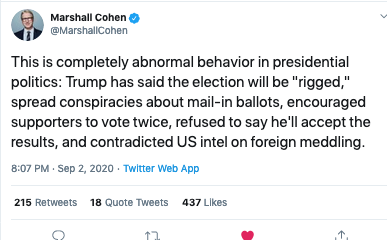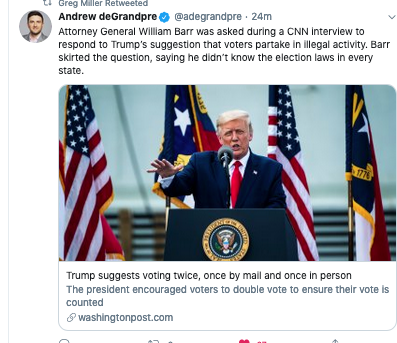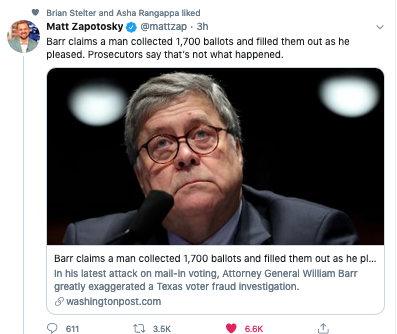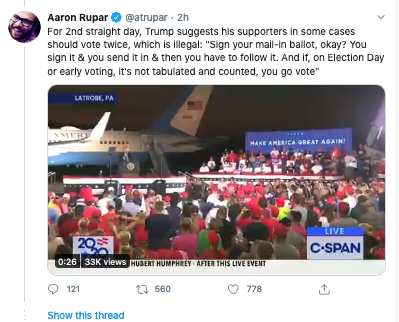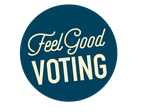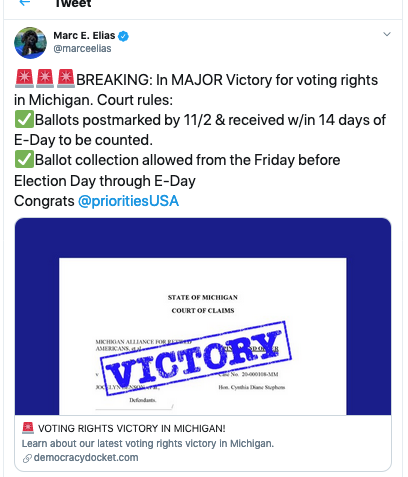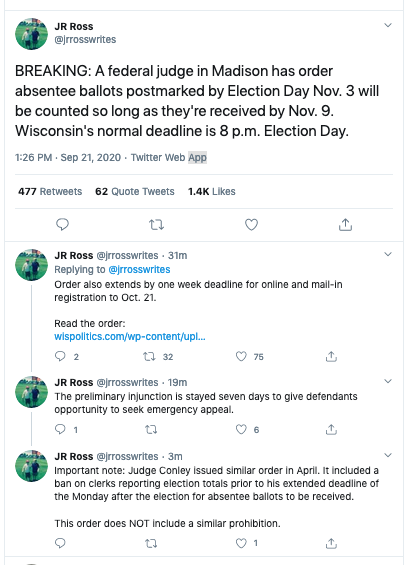This NY Times Magazine feature, out today is extremely alarming and explains what we can expect from the WH/Trump and R’s during this election. We know they are getting out the false message that the ballots are mishandled, via fearmongering, laying the groundwork and coming out swinging to call anything irregular, and thereby voter fraud. They will distort the message, amplify any problem…and yes, use every means to get the votes changed.
@Mynta check this out
WTFery…
From Brian Stelter’s newsletter
The “voter fraud” fraud
The New York Times Magazine 's next cover story is along these same lines. Jim Rutenberg 's five-month investigation, based on 100+ interviews, is about the right wing’s fraud about “voter fraud.”
Rutenberg’s story was posted on Wednesday. “The movement to convince the country that voter fraud is a present danger to democracy has itself become a present danger to democracy,” he concluded. Trump is using the “full force” of government to pursue this “false threat,” he wrote, all “in the service of one goal: to maintain his own grip on power .”
On an October morning four years ago, eight young staff members at the Indiana Voter Registration Project in Indianapolis were planning their final steps before a closely contested presidential election**. In recent weeks they had registered 45,000 new voters, most of whom were Black and Latino, and they were on track to enlist 10,000 more before Election Day**. Their work had gone smoothly for the most part, but several canvassers had submitted applications with names that appeared to have been made up or drawn from the phone book, most likely to create the appearance that they were doing more work than they had actually done. That was illegal — submitting a false registration is a felony under Indiana law — and also frustrating. A made-up name was not going to help anyone vote. The staff members stopped using the suspect canvassers, but they couldn’t simply trash the faulty registrations: State law required them to file every application they collected, even if they had false names or serious mistakes. So they carefully identified all the applications with potentially false names, along with several hundred more with incorrect addresses or other simple errors, so that local election clerks would know they might present a problem.
Despite their efforts at transparency, though, Indiana’s secretary of state, Connie Lawson, used these faulty registrations as evidence of wrongdoing. She warned all the state’s county elections clerks that a group of “nefarious actors” who were going “by the name of the Indiana Voter Registration Project” had “forged voter registrations.” It was a gross exaggeration, but the project hired a lawyer to visit local election board offices and assure registrars that they were following the proper procedures. Craig Varoga, a longtime Democratic operative who runs Patriot Majority USA, which funded the Indiana project, told reporters that the fraud claims were false. Lawson was a close ally of Mike Pence, the state’s former governor who was then Donald Trump’s running mate. “We believe she is using government resources,” Varoga said, “to discredit and impugn the entire process.”
But the staff members did not expect anything like what came that October morning. Around 10:45, five unmarked state police cars and a mobile cybercrimes unit quietly approached their building. A staff member heard a knock on the back door. Within minutes, troopers were rounding up the staff members inside the office, announcing that they had a warrant to search all their computers, cellphones and records. When one staff member, a young Black man, refused to give up his phone, the troopers handcuffed him — for “acting like a hoodlum,” he later said in a sworn affidavit. Within a couple of hours, the police were heading out the door with computers and phones as a television news crew captured the scene.
Pence seized on the investigation in interviews. “Voter fraud, Dana, is real,” he told the CNN correspondent Dana Bash. “We’re dealing with it in the state of Indiana right now. We have literally thousands of instances of fraudulent voter registration.” This claim was a misrepresentation, but it was of a piece with similar claims circulating around the country. The Pennsylvania State Police raided a Democratic firm that it said was suspected of producing fraudulent registrations. Conservative activists released a report titled “Alien Invasion in Virginia,” claiming that more than a thousand “noncitizens” there were poised to vote illegally. A video from Project Veritas’s right-wing video ambush artist James O’Keefe III caught a Democratic operative seemingly discussing a hypothetical “huge, massive voter-fraud scheme” in Wisconsin, as Sean Hannity described it. Some of the claims were simply nonsensical. Roger Stone, Trump’s longtime adviser, tweeted a fictitious document that purported to reveal a Democratic plan to attack American voters with mind-controlling “pulsed ELF electromagnetic emissions” and impose martial law, adding only, “If this is real: OMG!!!”
None of these stories held up under examination: The Pennsylvania authorities never followed the raid with a case; there were no official findings of illegal voting by noncitizens in Virginia; a Wisconsin attorney general’s investigation failed to uncover a “massive voter-fraud scheme.” In Indiana, a judge dismissed charges against a manager at the Indiana Voter Registration Project, and prosecutors dropped the cases against nine of its former canvassers after they agreed to pay fines and confirm as true the charges against them. Two of the former canvassers did plead guilty to making false statements on government forms and received sentences of community service and probation.

But all those headlines about voter fraud — amplified daily on Facebook and Twitter — served a purpose: They laid the groundwork for a legal challenge. The Trump campaign had a team of election lawyers standing by to dispute election results throughout the country, and the Republican National Lawyers Association had readied a self-described “Navy SEAL-type” operation to fight similar cases. In the event of a Republican loss, they would need a story, and fraud was it. The truth appeared to be a secondary concern at best.
Victory did little to change their stance. Shortly after his inauguration, President Trump told a bipartisan group of senators that his narrow loss in New Hampshire was due to voter fraud. Thousands of out-of-state voters apparently voted illegally, he said, after they were bused in to New Hampshire from Massachusetts. After Trump’s rant was leaked to reporters, the ABC anchor George Stephanopoulos asked the senior presidential adviser Stephen Miller if he really believed that to be the case. The practice of busing in illegal, out-of-state voters was “widely known” in New Hampshire, he said. But he declined to provide evidence, adding that “voter fraud is something we’re going to be looking at very seriously.”
As the 2020 presidential election nears, it is becoming clear that the Trump administration and the Republican Party are not just looking at but heavily investing in the largely nonexistent problem of voter fraud. A New York Times Magazine investigation, based on a review of thousands of pages of court records and interviews with more than 100 key players — lawyers, activists and current and former government officials — found an extensive effort to gain partisan advantage by aggressively promoting the false claim that voter fraud is a pervasive problem. The effort takes its most prominent form in the president’s own public statements, which relentlessly promote the false notion that voter fraud is rampant.
This story did not originate with Trump. It has its roots in Reconstruction-era efforts to suppress the votes of newly freed slaves and came roaring back to life after the passage of the Voting Rights Act. But it is reaching an apex now, as a president who lost the popular vote in 2016 and is currently trailing in the polls harnesses the reality-warping powers of social media and the resources of at least four federal agencies to undermine faith in an election he could very well lose.
Voter fraud is an adaptable fiction, and the president has tailored it to the moment. Even as the coronavirus pandemic poses a grave obstacle to his re-election, the crisis is providing him an opportunity to do what no other president has done before him: use the full force of the federal government to attack the democratic process, suppress the votes of American citizens and spread grievance and suspicion among his followers. Recently, perhaps predictably, the president has begun to suggest that because of his professed distrust in the election process, he will not agree to a peaceful transition of power.
It is remarkable, but not at all accidental, that a narrative built from minor incidents, gross exaggeration and outright fabrication is now at the center of the effort to re-elect the president. As we approach an election in which the threat of voter fraud is being used as a justification for unprecedented legal and political interventions in our democratic process, it is important to understand what this claim actually represents: It is nothing short of a decades-long disinformation campaign — sloppy, cynical and brazen, but often quite effective — carried out by a consistent cast of characters with a consistent story line. Even the Indiana Voter Registration Project remains in play. “In my own state of Indiana in 2012,” Pence said on Fox News in July, “literally, there was a group of people that were prosecuted for falsifying ballots.” He had the year wrong and the facts wrong. But the Indiana case was nevertheless proof, he said, that “the reality of voter fraud is undeniable.”
Can we move to Vote please??? And maybe someone insert an entry there, am maxed my 3.
Thanks @anon95374541 and @MissJava 
